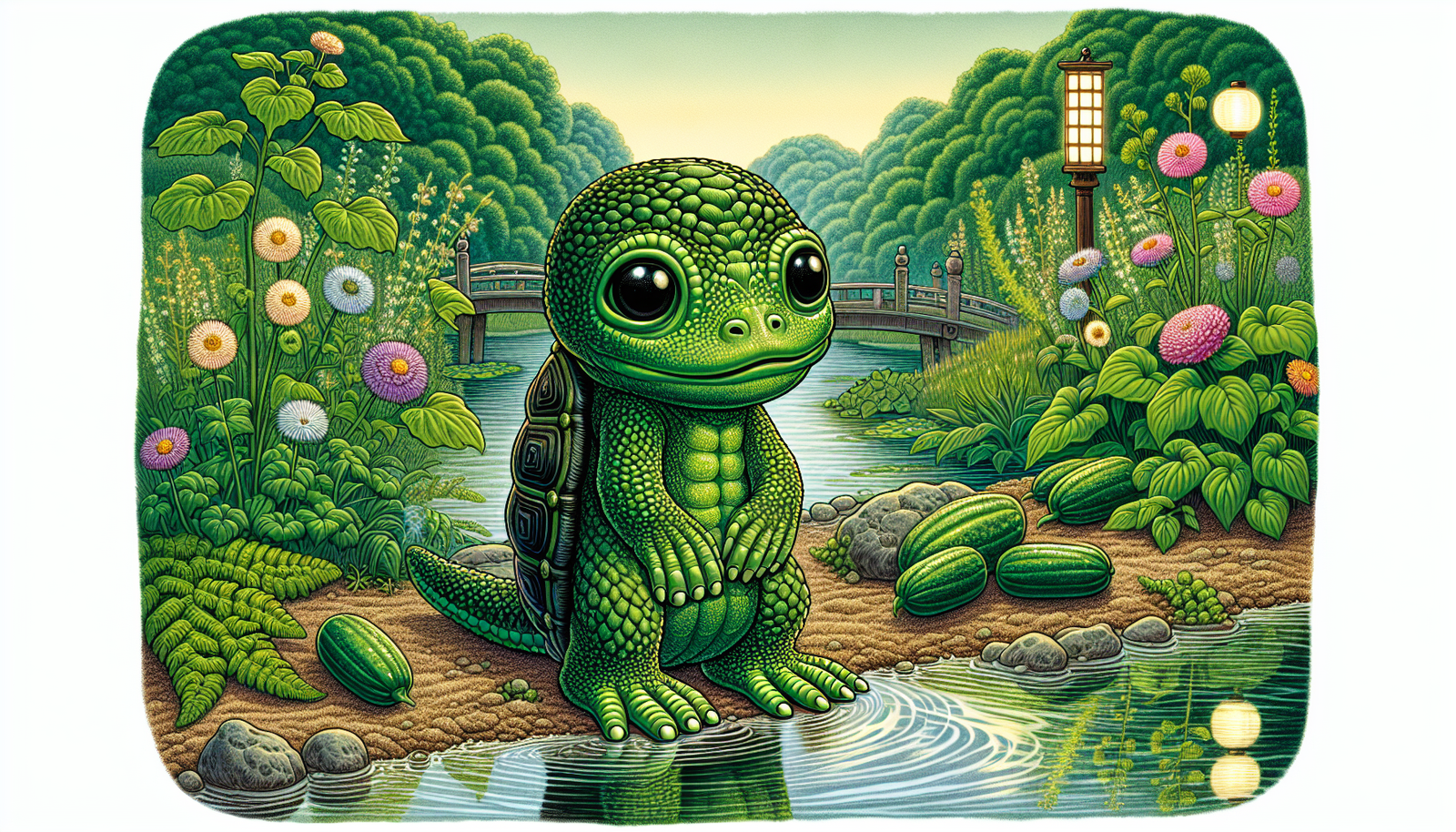The Kappa of Japanese Rivers: Japan's Water Spirit

By Wade Beaumont, Cryptozoologist
Well, howdy there, folks! Wade Beaumont here, and I'm fixin' to take y'all on a wild ride through the misty rivers and shadowy creeks of Japan. Now, I know what you're thinkin' - what's a good ol' boy from Texas doin' spinnin' yarns about Japanese water spirits? Well, let me tell you, when it comes to cryptids and legendary creatures, there ain't no borders that can hold back my curiosity. And let me tell you, the Kappa - now that's a critter that'd make even the most seasoned Bigfoot hunter sit up and take notice.
Picture this: you're standin' by a quiet river in the Japanese countryside, the water's runnin' smooth as silk, and the air's thick with the smell of damp earth and wild herbs. Suddenly, you catch a glimpse of somethin' movin' in the shallows - somethin' that ain't quite human, ain't quite animal, but somethin' altogether... different. That, my friends, is the Kappa, and it's about as fascinatin' a creature as you're likely to find this side of the Pacific.
Now, the Kappa ain't just some tall tale cooked up to scare kids away from swimmin' holes (though it sure does serve that purpose). No sir, this little fella is woven into the very fabric of Japanese culture, as much a part of their folklore as Bigfoot is to ours. It's a symbol of the wild, untamed nature of rivers and streams, a reminder of the power and danger that lurks beneath those placid waters. But it's also become somethin' of an environmental mascot in recent years, a pint-sized guardian of Japan's waterways.
In this here article, we're gonna dive deep into the world of the Kappa. We'll trace its origins back through the mists of time, examine every scale and webbed toe of its appearance, and explore the complex personality that makes this critter so dang intriguin'. We'll look at how it's been used to teach important lessons, how it's evolved in modern culture, and even how it's helpin' to protect the very waters it calls home. So strap in, folks - it's gonna be one heck of a ride!
Origins and Etymology of the Kappa
Now, let's start at the beginnin', as any good story should. The word "Kappa" itself is a mouthful of meaning, derived from two Japanese words: "kawa," meanin' river, and "wappa," meanin' child. Put 'em together, and you've got yourself a "River child". It's a fittin' name for these little fellas, seein' as they're about the size of a young'un and make their homes in the rivers and streams of Japan.
The Kappa's been around for a mighty long time, with some of the earliest mentions datin' back to the Edo period, which ran from 1603 to 1868. That's older than the state of Texas, folks! But some scholars reckon the Kappa's roots might stretch back even further, possibly all the way to the 8th century. There's talk of similar water spirits in ancient texts like the Nihon Shoki, which is kinda like Japan's version of our history books.
Now, here's where it gets real interestin'. Just like how Bigfoot goes by different names dependin' on where you are - Sasquatch, Skunk Ape, what have you - the Kappa's got more aliases than a Wild West outlaw. We're talkin' over 80 different names across Japan! In some parts, they call 'em "kawako," in others "gataro." Each region's got its own spin on the legend, with different traits and behaviors attributed to these slippery little critters.
This variety in names and characteristics ain't just a curiosity - it's a testament to how deeply the Kappa's embedded in Japanese folklore. It's like how every small town in Texas has its own local legend, each one a little different but all part of the bigger tapestry of our culture. The Kappa's the same way - it's not just one story, but a whole mess of 'em, each one adapted to fit the local landscape and the fears and hopes of the people livin' there.
Some folks reckon the Kappa might've been inspired by real critters, like the Japanese giant salamander. Now, I've seen some strange things in my time trackin' Bigfoot, but I gotta say, if I came across one of them salamanders in a murky river, I might just mistake it for a legendary creature myself! Others think the Kappa might be more of a metaphor, a way for folks to make sense of the dangers of swift-flowin' rivers and deep, dark pools.
Whatever its origins, the Kappa's managed to do somethin' that a lot of cryptids struggle with - it's stayed relevant. While a lot of old legends fade away like mornin' mist, the Kappa's adapted with the times. It's gone from bein' a feared monster to a beloved character in stories, and even a symbol for environmental protection. That's some serious stayin' power, folks.
The way I see it, the Kappa's like a river itself - always changin', always flowin', but always there. It's picked up bits and pieces from different times and places, just like a river picks up pebbles and leaves, until it's become this rich, complex figure that means different things to different people. And that, my friends, is what makes it so dang fascinatin' to study.
Physical Characteristics of the Kappa
Alright, folks, let's get down to the nitty-gritty and paint us a picture of what these Kappa critters look like. Now, I've spent many a night in the woods lookin' for Bigfoot, and let me tell you, if I ever came across a Kappa, I reckon I'd know it right away. These fellas are about as distinctive as a longhorn in a sheep pasture.
First off, size-wise, we're talkin' about a critter that's roughly the size of a young child. Now, don't let that fool you into thinkin' they're harmless - remember, even a rattlesnake ain't all that big, but it can still pack a wallop. The Kappa's got a humanoid shape, meanin' it's got two arms, two legs, and walks upright like we do. But that's about where the similarities to us humans end.
The skin of a Kappa is usually described as bein' green or a yellowish-green, kinda like the color of algae-covered rocks in a riverbed. It's said to be scaly or slimy, dependin' on who you ask, which makes sense for a critter that spends most of its time in the water. Some folks say it's got a fishy smell to it, which ain't too surprisin' considerin' its habitat.
Now, here's where it starts gettin' real interestin'. The Kappa's got webbed hands and feet, like a frog or a duck. This makes 'em excellent swimmers, able to glide through the water as smooth as silk. On its back, it's sportin' a shell like a turtle. This ain't just for show - it provides protection and might even help with floatin'.
But the most distinctive feature of the Kappa, the thing that really sets it apart, is what's on top of its head. Imagine, if you will, a small bowl or dish, right there on the crown of its noggin. This ain't just some strange fashion choice - it's called the "sara," and it's crucial to the Kappa's survival. This sara is always filled with water, and it's said to be the source of the Kappa's power and strength.
Now, here's the kicker - if that water spills out or dries up, the Kappa's in big trouble. It becomes weak, unable to move, and some stories even say it might die. It's like how we humans need water to survive, but for the Kappa, it's right there on top of its head, plain as day. This quirk of anatomy has led to all sorts of tales about how to outsmart a Kappa, which we'll get into later.
The Kappa's face is another thing altogether. It's got a beak-like mouth, often described as bein' sharp and dangerous-lookin'. Its eyes are usually portrayed as bein' round and bulgin', givin' it a somewhat comical appearance despite its fearsome reputation. Around the sara on its head, it's said to have hair growin' in a ring, almost like a monk's tonsure.
Now, here's a detail that might make you chuckle - or squirm, dependin' on your disposition. Kappa are said to have not one, not two, but three anuses. Yep, you heard that right. This peculiar trait is said to allow them to pass gas at three times the rate of a normal creature. It's details like this that really bring home how these legends evolved over time, with each storyteller addin' their own embellishments.
The Kappa's arms are another point of interest. Some stories say they're connected to each other inside the Kappa's body, runnin' through the torso. This means that if you pull on one arm, the other one retracts. It's a strange feature, to be sure, but it adds to the otherworldly nature of the creature.
All these physical traits come together to create a being that's both familiar and alien. It's got elements of things we recognize - turtles, frogs, children - but combined in a way that's entirely unique. It's this blend of the familiar and the strange that makes the Kappa so intriguin', and so enduring in Japanese folklore.
In my line of work, studyin' cryptids and legendary creatures, I've come across all sorts of descriptions of strange beings. But I gotta say, the Kappa stands out. It's not just a big, hairy humanoid like Bigfoot, or a prehistoric survivor like the Loch Ness Monster. It's a creature that seems perfectly adapted to its environment, with features that speak to both its physical habitat and its place in the human imagination.
The Kappa's appearance tells us a lot about the culture that created it. The webbed hands and feet, the turtle-like shell - these speak to a people intimately familiar with life around rivers and lakes. The sara on its head, always needin' to be filled with water, might be seen as a metaphor for the constant vigilance needed when livin' near potentially dangerous waters.
And let's not forget, appearances can be deceivin'. Despite its somewhat comical look, with its round eyes and beak-like mouth, the Kappa is often portrayed as a dangerous creature. It's a reminder that in nature, and in life, things ain't always what they seem at first glance.
So next time you're standin' by a river, especially if you ever find yourself in Japan, keep your eyes peeled. You might just catch a glimpse of a small, green figure with a dish on its head, watchin' you from the shallows. And if you do, remember - appearances ain't everything, and even the strangest-lookin' critter might have more to it than meets the eye.
Behavior and Personality of the Kappa
Now, folks, if you thought the Kappa's appearance was a wild ride, just wait 'til you hear about its behavior. These little river dwellers are about as complex as they come, with a personality that's more layered than a stack of flapjacks at a Sunday morning breakfast.
Mischievous Nature
First off, let's talk about their mischievous side. Kappa are known for bein' playful tricksters, not unlike the coyote in some Native American legends. They've got a reputation for playin' pranks on humans, and they seem to take a particular delight in causin' a ruckus. Now, some of these pranks are relatively harmless - things like makin' loud fartin' noises to embarrass folks, or peekin' up women's kimonos. It's the kind of behavior that'd get a human child a stern talkin' to, but for a Kappa, it's just another day by the river.
Challenges and Contests
But here's where it gets interestin' - Kappa ain't just content with simple pranks. They've got a real fondness for challengin' humans to tests of strength or skill. Their favorite contest? Sumo wrestlin'. That's right, these little fellas, no bigger than a child, love to challenge full-grown humans to wrestlin' matches. It's like if a raccoon challenged you to an arm-wrestlin' contest - unexpected, to say the least.
Darker Side
Now, you might be thinkin' this sounds kinda cute, maybe even endearing. But hold your horses, 'cause we're about to take a turn down a darker path. You see, Kappa ain't always content with harmless mischief. They've got a mean streak a mile wide, and when it shows, it ain't pretty.
In many stories, Kappa are said to drag unwary people and animals into the water to drown 'em. They've got a particular dislike for horses and cattle, and there are plenty of tales about Kappa pullin' livestock into rivers. But it's their treatment of humans that's really hair-raisin'. According to legend, Kappa don't just drown their victims - they've got a hankerin' for a certain part of the human body called the shirikodama.
Now, the shirikodama is a mythical ball said to contain the human soul, located... well, let's just say it's in a rather personal area. The Kappa is said to have a peculiar fondness for this organ, often goin' to great lengths to obtain it. It's a grisly detail, to be sure, and one that really drives home the dangerous nature of these creatures.
Code of Honor
But here's where it gets real interestin' - despite their often malevolent behavior, Kappa ain't all bad. In fact, they're known to have a strong sense of honor and an obsession with politeness. This quirk has led to many tales of humans outwittin' Kappa by usin' their own code of conduct against 'em.
For example, Kappa are said to be unable to resist returnin' a bow if someone bows to them. The trick is, when they bow, the water spills out of the sara on their head, weakenin' 'em considerably. It's a reminder that even the wiliest creature can be undone by its own nature.
Potential for Good
Moreover, if a human manages to befriend a Kappa or do it a good turn, the creature can become a powerful ally. There are stories of Kappa sharin' medical knowledge with humans, particularly in the art of settin' bones. Some tales even credit Kappa with teachin' humans about irrigation techniques, helpin' farmers to better manage their water resources.
This dual nature - the capacity for both mischief and malevolence, as well as honor and helpfulness - makes the Kappa a fascinatin' figure. It's not just a monster to be feared, nor is it a harmless sprite to be taken lightly. Instead, it's a complex being that demands respect and caution in equal measure.
Reflection of Nature
In many ways, the Kappa's behavior mirrors the nature of the rivers and streams it inhabits. Rivers can be playful and life-giving, but they can also be dangerous and destructive. The Kappa embodies this duality, servin' as a powerful reminder of the respect we ought to have for natural forces.
The Kappa's love for sumo wrestlin' and challenges of strength might seem odd at first glance, but it speaks to a deeper aspect of Japanese culture. Sumo is more than just a sport in Japan - it's a centuries-old tradition with deep spiritual significance. By associatin' Kappa with sumo, the legends tie these creatures to an important aspect of Japanese cultural identity.
Their penchant for pranks and mischief, meanwhile, serves an important function in the stories. It makes the Kappa more than just a mindless monster - it gives them personality, makes them almost relatable in a way. We've all known someone who loves a good prank, after all. But the darker aspects of their behavior serve as a warning, a reminder that nature, for all its beauty, can be cruel and unforgiving.
The Kappa's obsession with politeness and their inability to resist returnin' a bow is particularly interesting. It suggests that even supernatural beings are bound by the rules of society, and that good manners can be a powerful tool even in the face of danger. It's a very Japanese concept, reflectin' the importance of etiquette and proper behavior in their culture.
Their potential for both harm and help is another important aspect of Kappa lore. By portrayin' these creatures as capable of sharin' valuable knowledge and skills, the legends suggest that nature, while dangerous, is also a source of wisdom and resources if approached with respect and caution.
In my years of studyin' cryptids and folklore, I've come across all sorts of creatures with all sorts of behaviors. But the Kappa stands out for its complexity. It ain't just a monster to be feared or a spirit to be worshipped - it's a multifaceted being that can be friend or foe, helper or hindrance, depending on how it's treated.
This complexity makes the Kappa more than just a simple bogeyman used to scare kids away from dangerous waters. It's a figure that encapsulates a whole philosophy about how humans should interact with nature - with respect, caution, and the understanding that there's always more than meets the eye.
So next time you're by a river, whether it's the mighty Mississippi or a little creek in your backyard, take a moment to think about the Kappa. Remember that nature, like these legendary creatures, has many faces - playful and dangerous, helpful and harmful. And always, always remember to mind your manners. You never know when a polite bow might just save your hide.
The Kappa's Love for Cucumbers
Now, folks, we've covered a lot of ground when it comes to the Kappa - their looks, their behavior, their penchant for mischief and mayhem. But there's one aspect of these critters that's so dang peculiar, so downright fascinatin', that it deserves its own chapter. I'm talkin', of course, about the Kappa's legendary love for cucumbers.
That's right, you heard me correct - cucumbers. Now, I know what you're thinkin'. "Wade," you're sayin', "what in tarnation does a river spirit have to do with a garden vegetable?" Well, let me tell you, in the world of Kappa lore, cucumbers are about as important as water itself.
Cucumber Obsession
The Kappa's obsession with cucumbers is deeply ingrained in Japanese folklore. It's said that a cucumber is the one thing a Kappa loves more than human flesh or the mysterious shirikodama. Now, that's what I call a powerful craving! This quirk of the Kappa's personality has led to all sorts of traditions and customs in Japan, some of which continue to this day.
Historical Traditions
Back in the Edo period (that's 1603 to 1868 for those of you keepin' track), folks had an interestin' way of protectin' themselves from Kappa attacks. They'd write the names of their family members on cucumbers and toss 'em into rivers or streams. The idea was that the Kappa would be so pleased with the offering that they'd leave the family alone. It's like leavin' cookies for Santa Claus, except instead of gettin' presents, you're hopin' not to get drowned by a river imp.
This tradition speaks volumes about the complex relationship between humans and Kappa in Japanese folklore. On one hand, the Kappa is feared as a dangerous creature capable of causin' harm. On the other hand, it's seen as a being that can be reasoned with, appeased, even befriended if approached the right way. The cucumber offerings are a way of establishin' a kind of truce with these unpredictable spirits.
Modern Influence
Now, the cucumber connection ain't just limited to folklore and old traditions. It's made its way into modern Japanese cuisine in a way that might surprise you. Ever heard of kappa-maki? It's a type of sushi roll that's filled with - you guessed it - cucumber. The name is a direct reference to our cucumber-lovin' friends, and it's a popular dish in sushi restaurants all over Japan and beyond.
The existence of kappa-maki shows just how deeply the Kappa legend has permeated Japanese culture. It's not just a scary story or an old superstition - it's become a part of everyday life, somethin' people encounter regularly even if they're not thinkin' about the folklore behind it.
Theories Behind the Cucumber Love
But why cucumbers? What is it about this particular vegetable that's supposed to drive Kappa wild? Well, there are a few theories. Some folks reckon it's because the cucumber resembles the Kappa's favorite body part (remember that shirikodama we talked about earlier?). Others think it might be because cucumbers float, making them easy for the Kappa to spot in the water.
Personally, I think it might have somethin' to do with the cucumber's association with coolness and refreshment. In the hot, humid summers of Japan, a cool cucumber might seem mighty temptin' to a river-dwellin' spirit. Plus, cucumbers are mostly water themselves, which would appeal to a water-based creature like the Kappa.
Superstitions and Beliefs
Whatever the reason, the cucumber connection has become an integral part of Kappa lore. It's even led to some interestin' superstitions. In some parts of Japan, it's said that you shouldn't eat cucumbers and then go swimmin', because the smell might attract Kappa. In other areas, though, people believe that eatin' a cucumber before swimmin' will protect you from Kappa attacks. It just goes to show how these legends can vary from place to place.
Cultural Significance
The cucumber obsession also adds an interestin' dimension to the Kappa's character. Despite their fearsome reputation, the fact that they can be placated with somethin' as simple and harmless as a cucumber makes them seem almost... cute. It's a reminder that even the scariest monsters have their weaknesses, their quirks that make them more than just figures of terror.
In some ways, the Kappa's love for cucumbers serves as a bridge between the human world and the world of spirits. It's somethin' tangible, somethin' real that connects our everyday experience to these legendary creatures. After all, anyone can grow a cucumber or buy one at the store. It makes the world of the Kappa feel a little closer, a little more accessible.
This aspect of Kappa lore also highlights the importance of offerin's and respect in Japanese culture. The idea that you can appease a potentially dangerous spirit with a simple gift is a powerful one. It suggests that with the right approach, even the most fearsome forces can be negotiated with.
Comparison to Other Folklore
In my years of studyin' folklore and cryptids, I've come across all sorts of strange dietary habits attributed to legendary creatures. Bigfoot's supposed to have a hankerin' for apples, while the Chupacabra's got a thing for goat blood. But I gotta say, the Kappa's cucumber obsession takes the cake - or should I say, takes the sushi roll.
It's a reminder that when it comes to folklore, it's often the small, quirky details that really bring a legend to life. The Kappa ain't just a scary monster lurkin' in the water - it's a creature with its own likes and dislikes, its own peculiar tastes. And somehow, knowin' that it's got a weakness for cucumbers makes it feel more real, more alive in our imaginations.
So next time you're choppin' up a cucumber for your salad, or orderin' some kappa-maki at your local sushi joint, spare a thought for the Kappa. Who knows - maybe by enjoyin' their favorite snack, you're payin' them a kind of tribute. Just don't go swimmin' right after, unless you're lookin' for a close encounter of the Kappa kind!
Kappa in Folklore and Cautionary Tales
Alright, folks, now we're gonna dive into the heart of Kappa lore - the stories, legends, and cautionary tales that have kept this creature alive in the Japanese imagination for centuries. You see, the Kappa ain't just some random monster thought up to give folks a scare. No sir, these little river imps play a crucial role in Japanese folklore, servin' as both a warnin' and a lesson to generations of people.
Water Safety Lessons
First and foremost, Kappa stories have long been used as a way to keep children safe around water. Now, if you've ever spent time around rivers or lakes, you know how dangerous they can be, especially for little ones who might not understand the risks. Back in the day, before fancy swimmin' lessons and life jackets, parents needed a way to make sure their kids stayed away from deep water. Enter the Kappa.
Imagine you're a young'un in old Japan, and your ma tells you about these creatures that live in the river, waitin' to drag unsuspecting children under the water. You'd think twice about wanderin' too close to the water's edge, wouldn't you? It's a powerful deterrent, much more effective than just sayin' "stay away from the river." By givin' the danger a face and a name, these stories made the threat feel real and immediate to children.
Lessons on Respect and Behavior
But Kappa tales ain't just about scarin' kids straight. They often contain important lessons about respect for nature and the importance of proper behavior. Remember how we talked about the Kappa's obsession with politeness? Well, many Kappa stories revolve around the idea that if you show proper respect and manners, even a fearsome creature like a Kappa can be pacified or even befriended.
Take, for example, the common tale of a human outwitting a Kappa by bowing to it. The Kappa, bound by its code of politeness, bows back, spillin' the water from its sara and renderin' itself powerless. This story ain't just a clever trick for defeatin' monsters - it's a lesson about the power of good manners and the importance of followin' social rules, even in the face of danger.
Cleverness Over Strength
Another popular type of Kappa tale involves the creature challengin' humans to tests of strength or skill, often in the form of sumo wrestlin'. These stories usually end with the human winnin' through cleverness rather than brute force, often by trickin' the Kappa into spillin' the water from its head. It's a classic "brain over brawn" scenario, teachin' listeners that wit and wisdom can overcome even the most formidable opponents.
Lessons on Compassion
Then there are the stories of Kappa bein' captured or injured by humans, only to be shown mercy. In return, the grateful Kappa shares valuable knowledge, like medical techniques or irrigation methods. These tales teach the value of compassion and the potential rewards of showin' kindness, even to those who might seem like enemies.
The Tono Legend
One particularly famous Kappa legend comes from the town of Tono in Iwate Prefecture. The story goes that a Kappa was caught tryin' to drag a horse into the river. The quick-thinkin' owner of the horse managed to pull the Kappa onto dry land, where it was at a disadvantage. Instead of killin' the creature, the man offered to let it go if it promised never to harm the people of the village again. The Kappa agreed, and from then on, it became a protector of the village rather than a threat.
This story, like many Kappa tales, blurs the line between the Kappa as a malevolent creature and a potential ally. It suggests that even the most dangerous forces of nature can be turned to good if approached with bravery, cleverness, and compassion.
Darker Tales
Now, it's worth noting' that not all Kappa stories have happy endings. There are plenty of grim tales about people who didn't heed the warnings and fell victim to these river spirits. These darker stories serve as a stark reminder of the consequences of ignorin' the dangers of the natural world.
For instance, there's a common motif in Kappa folklore about women bein' attacked or even impregnated by Kappa while usin' outdoor toilets that were often built over flowing water. These unsettlin' tales served as a warning about the vulnerability of bein' alone in isolated areas, especially near water.
Another recurring theme in Kappa stories is their attacks on livestock, particularly horses. Many tales describe Kappa draggin' horses into rivers to drown them. These stories might have served as an explanation for the very real danger of animals bein' swept away by strong currents or gettin' stuck in mud near riverbanks.
Evolution of Kappa Tales
What's particularly interestin' about Kappa folklore is how it's evolved over time. In the past, Kappa were primarily seen as dangerous creatures to be feared and avoided. But as Japan modernized and the immediate dangers of river life became less pressing, the image of the Kappa began to soften.
Nowadays, while the cautionary aspect of Kappa tales is still present, there's been a shift towards portrayin' them in a more positive light. Modern stories often depict Kappa as mischievous but ultimately harmless creatures, or even as protectors of the environment. This evolution reflects changin' attitudes towards nature in Japanese society, from somethin' to be feared and conquered to somethin' to be respected and protected.
Kappa Festivals
In some areas of Japan, there are even festivals and celebrations centered around Kappa. These events often involve people dressin' up as Kappa, sharin' Kappa-themed food (like cucumber dishes, of course), and retelling old Kappa tales. It's a way of keepin' the folklore alive while also celebrating local history and culture.
Enduring Popularity
The enduring popularity of Kappa stories speaks to their power and versatility as teaching tools. Whether they're bein' used to warn about the dangers of water, teach the importance of good manners, or encourage environmental conservation, Kappa tales continue to resonate with people of all ages.
In my line of work, studyin' cryptids and folklore, I've come across all sorts of cautionary tales from around the world. But I gotta say, the Kappa stories stand out for their complexity and depth. They ain't just simple scare tactics or morality tales - they're a rich tapestry of cultural beliefs, practical warnings, and timeless lessons about how to navigate both the natural world and human society.
These stories remind us that folklore ain't just about entertainment or preservin' old superstitions. It's a way of passin' down important knowledge from one generation to the next, wrapped up in a package that's memorable and engaging. The Kappa, with its strange appearance and complex personality, serves as the perfect vehicle for these lessons.
From Bigfoot to UFOs: Hangar 1 Publishing Has You Covered!
Explore Untold Stories: Venture into the world of UFOs, cryptids, Bigfoot, and beyond. Every story is a journey into the extraordinary.
Immersive Book Technology: Experience real videos, sights, and sounds within our books. Its not just reading; its an adventure.



























